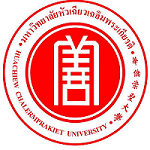Please use this identifier to cite or link to this item:
https://has.hcu.ac.th/jspui/handle/123456789/4790| Title: | ความสัมพันธ์ระหว่างความคิดเชิงบริหารและทักษะการเคลื่อนไหวในเด็กวัยเรียนอายุ 7-10 ปี |
| Other Titles: | The relationship between executive function and motor skills of school-aged children 7-10 years old |
| Authors: | สุภาณี ชวนเชย เจนจิรา อัสพันธ์ วรรณิษา แสนพันธ์ บุญรัตน์ โง้วตระกูล Supanee Chounchay Jenjira Assapun Wannisa Saenphan Boonrat Ngowtrakul Huachiew Chalermprakiet University. Faculty of Physical Therapy Huachiew Chalermprakiet University. Faculty of Physical Therapy Huachiew Chalermprakiet University. Faculty of Physical Therapy Huachiew Chalermprakiet University. Faculty of Physical Therapy |
| Keywords: | พัฒนาการของเด็ก Child development เด็ก -- การเจริญเติบโต Children -- Growth เด็ก -- การเคลื่อนไหว Children -- Movements ความสามารถทางการบริหารในเด็ก |
| Issue Date: | 2023 |
| Citation: | วารสารกายภาพบำบัด 45, 2 (พฤษภาคม-สิงหาคม 2566) : 112-123 |
| Abstract: | ที่มาและความสำคัญ: เทคโนโลยีเข้ามามีบทบาทต่อการใช้ชีวิตในวัยเด็กเพิ่มสูงขึ้นส่งผลให้เด็กไทยมีพัฒนาการที่ถดถอยลงทั้งทางด้านร่างกายและความคิด ทำให้เด็กเสี่ยงต่อความบกพร่องทางการเรียนรู้ อย่างไรก็ตาม ยังไม่มีการศึกษาใดที่แสดงถึงความสัมพันธ์ระหว่างทักษะการเคลื่อนไหวและทักษะทางความคิดเชิงบริหารของเด็กวัยประถม
วัตถุประสงค์: เพื่อศึกษาความสัมพันธ์ระหว่างทักษะทางความคิดเชิงบริหารด้านความจำ เพื่อใช้งาน การยั้งคิดไตร่ตรอง และความยืดหยุ่นทางความคิด กับทักษะการเคลื่อนไหวในเด็กอายุ 7-10 ปี ประกอบด้วย ความคล่องแคล่วของทักษะการใช้มือ การเคลื่อนไหวแบบมีเป้าหมาย และความสามารถในการทรงตัว
วิธีการวิจัย:นักเรียนระดับประถมศึกษาเพศชายและหญิ ง อายุ 7-10 ปี จำนวน 84 คน ได้รับการทดสอบทักษะพื้นฐานทางความคิดเชิงบริหาร 3 ด้านหลัก ได้แก่ (1) ความจำเพื่อใช้งาน ทดสอบด้วย digit span test (2) การยั้งคิดไตร่ตรองทดสอบด้วย stroop color and word test และ (3) ความยืดหยุ่นทางความคิดทดสอบด้วย trail making test และได้รับการทดสอบทักษะการเคลื่อนไหวด้วยชุดทดสอบ movement assessment battery for children-2 (MABC-2) ประกอบด้วย ความคล่องแคล่วของทักษะการใช้มือ การเคลื่อนไหวแบบมีเป้าหมาย และความสามารถในการทรงตัว จากนั้นวิเคราะห์หาค่าความสัมพันธ์ทางสถิติ ด้วยสหสัมพันธ์สเปียร์แมน (Spearman correlation coefficient; rs) กำหนดค่านัยสำคัญทางสถิติน้อยกว่า 0.05
ผลการวิจัย: พบความสัมพันธ์อย่างมีนัยสำคัญทางสถิติในทิศทางตรงกันข้ามระหว่างทักษะทางความคิดเชิงบริหารด้านความยืดหยุ่นทางความคิดกับคะแนนรวม ทักษะการเคลื่อนไหว (rs= -0.331, p= 0.002) ความคล่องแคล่วของทักษะการใช้มือ (rs= -0.267, p= 0.014) แ ละความสามารถในการทรงตัว (rs= -0.280, p= 0.010) อย่างไรก็ตามไม่พบความสัมพันธ์อย่างมีนัยสำคัญทางสถิติระหว่างทักษะทางความคิดเชิงบริหารด้านความจำเพื่อใช้งาน
และการยั้งคิดไตร่ตรองกับทักษะการเคลื่อนไหว (p> 0.05)
สรุปผล: ทักษะทางความคิดเชิงบริหารด้านความยืดหยุ่นทางความคิดที่ดีมีความสัมพันธ์กับทักษะการเคลื่อนไหวที่ดีในเด็กอายุ 7 ถึง 10 ปี โดยเฉพาะอย่างยิ่งความคล่องแคล่วของทักษะการใช้มือและความสามารถในการทรงตัว Background: Technology plays an important role in daily life for children. As a result, physical and cognitive development in Thai children has declined. Consequently, their learning ability is poor. However, the relationship between motor skills and executive function in elementary school-aged children is still unclear. Objective: To evaluate the association between executive function and motor skills in children aged 7 -10 years. Methods: The participants comprised 84 boys and girls aged 7-1 0 years. All participants were assessed three domains of executive function, including working memory, inhibitory control, and cognitive flexibility using a digit span test, stroop color and word test, and trail making test, respectively. In addition, they were tested with a movement assessment battery for children -2 (MABC-2) test, which consisted of manual dexterity, aiming and catching, and balance. All data were analyzed for statistical correlation by Spearman correlation coefficient, at p-value<0.05. Results: The cognitive flexibility was found statistically negative correlation with motor skills (rs= -0.331, p= 0.002), manual dexterity (rs= -0.267, p= 0.014) and balance (rs= -0.280, p= 0.010). However, there was no statistical correlation between working memory, inhibitory control, and motor skills. Conclusion: Cognitive flexibility is associated with manual dexterity and balance in school-aged children 7 to 10 years old. |
| Description: | สามารถเข้าถึงบทความฉบับเต็ม (Full Text) ได้ที่ : https://he02.tci-thaijo.org/index.php/tjpt/article/view/258837/180457 |
| URI: | https://has.hcu.ac.th/jspui/handle/123456789/4790 |
| Appears in Collections: | Physical Therapy - Articles Journals |
Files in This Item:
| File | Description | Size | Format | |
|---|---|---|---|---|
| The-relationship-between-executive-function-and-moto-skills-of-school-aged-children-7-10years-old.pdf | 86.5 kB | Adobe PDF | View/Open |
Items in DSpace are protected by copyright, with all rights reserved, unless otherwise indicated.
